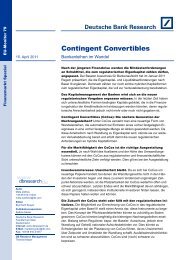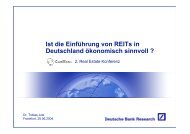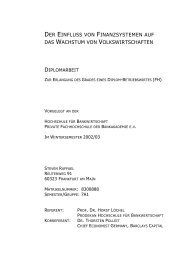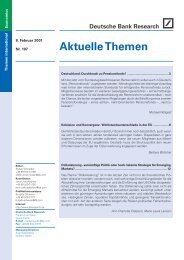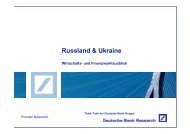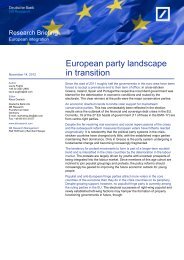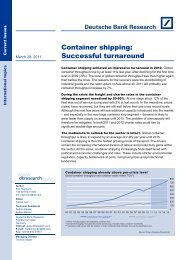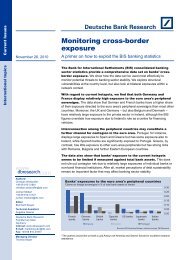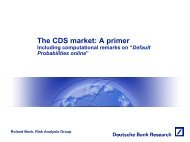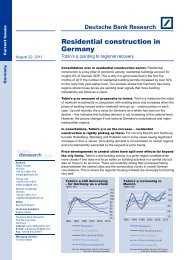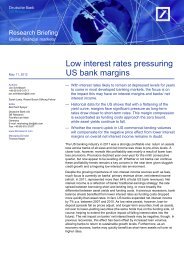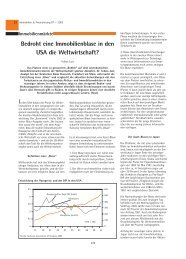Dynamic diversity opens up opportunities - Deutsche Bank Research
Dynamic diversity opens up opportunities - Deutsche Bank Research
Dynamic diversity opens up opportunities - Deutsche Bank Research
Create successful ePaper yourself
Turn your PDF publications into a flip-book with our unique Google optimized e-Paper software.
Export obstacles for SMEs<br />
(EU-27)<br />
Lack of knowledge of<br />
foreign markets: 13%<br />
Other<br />
reasons:<br />
33%<br />
When the little dragons awake<br />
– China’s SMEs<br />
It is a complex job to define and differentiate<br />
SMEs in China, since Chinese statistics in<br />
some cases include firms that are very large<br />
also by Western standards with <strong>up</strong> to 2,000<br />
workers. Besides, not all SMEs are in private<br />
hands, which makes it even more difficult to<br />
define the term. Up to the 1980s most SMEs<br />
were still referred to as ―town and village<br />
enterprises‖.<br />
According to data from the census of 2004<br />
there are roughly 40 m private SMEs operating<br />
in China. This contrasts with the roughly 19 m<br />
SMEs in the EU and around 6 m in the US. To<br />
achieve the same density of SMEs to total<br />
enterprises like in other countries the number<br />
would have to rise to about 60 m.<br />
Only slowly increasing domestic demand is<br />
compelling many companies to enter the<br />
international market – a step which is<br />
encouraged by new technologies. Unlike in the<br />
OECD countries most of China's exports come<br />
from small and medium-sized enterprises.<br />
Frequently, it is returned emigrants who were<br />
educated abroad that are now setting <strong>up</strong><br />
successful, internationally operating Chinese<br />
companies. A low wage level gives China’s<br />
SMEs a large cost advantage.<br />
Source: CESifo Forum, Chris Hall Macquarie School Sydney,<br />
2007.<br />
Capital<br />
constraints :<br />
9%<br />
No<br />
problems:<br />
36 %<br />
Import<br />
duties: 9 %<br />
Source: European Commission 2007 29<br />
Current Issues<br />
barriers, different legislation and sales markets as well as trade<br />
barriers caused by differing regulatory regimes hamper goods and<br />
services flows to a greater degree than in the US. The Small<br />
Business Act for Europe is meant to dismantle the remaining<br />
barriers in intra-European trade and help to lighten the load on<br />
SMEs.<br />
Fewer than 10% of European SMEs are exporters, whereas 28% of<br />
large companies generate revenues this way. 34 According to<br />
surveys, most European SMEs see the main trade barriers as a lack<br />
of knowledge about the foreign market (13%), import duties (9%)<br />
and capital constraints (9%). Nonetheless, in some countries over<br />
20% of the SMEs are engaged in export trade. In small domestic<br />
markets such as Luxembourg more than elsewhere, companies look<br />
more intently for <strong>opportunities</strong> abroad.<br />
Furthermore, in order to reduce the geographical distance from their<br />
customers, 5% of European SMEs opt to form joint ventures or<br />
maintain subsidiaries abroad. Contrary to frequently heard worries,<br />
these foreign links usually have either no impact on domestic<br />
employment figures or even have a positive impact. 35<br />
Even though the Central and Eastern European countries are<br />
increasingly growing in stature as trade partners, European SMEs<br />
are in some cases still sceptical about the enlarged EU. However,<br />
the higher their export ratio becomes, the more positive the SMEs’<br />
attitude.<br />
German SMEs: Foreign business is worthwhile<br />
The past few years have seen German SMEs post an increase in<br />
both their export ratios and in the number of exporters among their<br />
small firms. According to Germany’s KfW, over 20% of the SMEs<br />
have reported foreign turnover (21% of the SMEs with five or fewer<br />
employees). By contrast, in the turnover tax statistics it emerges that<br />
only about 11% of all SMEs export goods or services. However, it is<br />
assumed that the exporting activity of micro firms is higher than<br />
reported in the company tax statistics. 36 In 2004, around 250,000<br />
SMEs and 5,000 large companies exported goods to countries<br />
outside the EU. 37 Taken together, a clear trend emerges showing<br />
that the export ratio increases in line with company size – <strong>up</strong> to and<br />
including large companies, of which 81% are involved in export<br />
trade. Even though most of the internationally operating firms focus<br />
solely on exports from the home market, around 50% also maintain<br />
cooperative ventures and/or direct investments abroad. 38<br />
The main exporter is manufacturing industry, which is responsible<br />
for two-thirds of all exports. However, the biggest growth over the<br />
past few years was registered by distributive trade and services.<br />
Manufacturing industry is also the chief customer in terms of<br />
34<br />
European Commission (2007). The Observatory of European SMEs.<br />
35<br />
IfM Bonn – Bedeutung der außenwirtschaftlichen Aktivitäten für den deutschen<br />
Mittelstand.<br />
36<br />
KfW Mittelstandsmonitor (2008). Mittelstand – auch kleine Unternehmen –<br />
erfolgreich im Ausland. KfW (2008). Wie international ist der deutsche Mittelstand?<br />
Wirtschaftsobserver Online, No. 34. Besides, newer data evaluations suggest that<br />
15-25% of micro firms export their product, since many micro firms are not<br />
captured by company tax statistics.<br />
37<br />
IfM Bonn’s calculations from turnover tax statistics. Wallau, Frank (2007).<br />
Internationalisierung der mittelständischen Wirtschaft – Chancen und Risiken. A<br />
report issued by the KfW (Wirtschaftsobserver No. 34) attributes differences in the<br />
data from the turnover tax statistics and surveys to the fact that exporting activity is<br />
overestimated in surveys yet underestimated in official statistics.<br />
38<br />
IfM Bonn (2007). SMEs with turnover of more than EUR 125,000.<br />
20 April 15, 2009



